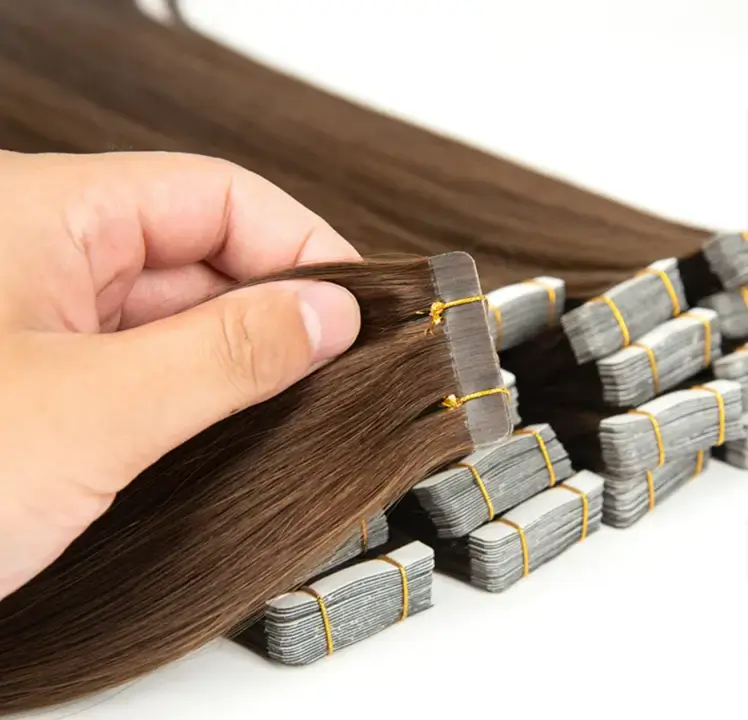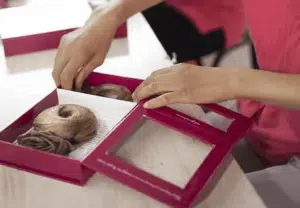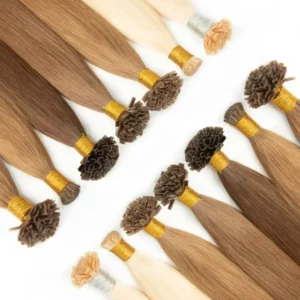Tape-in hair extensions are one of the most popular, time-efficient systems today. Are you curious why people choose them and when they work best? Let’s walk through what they are, how they’re applied, and what you should expect.
Tape-in hair extensions are thin panels of human hair with medical-grade adhesive on the top. You place a clean slice of natural hair between two tapes to form a flat “sandwich.” They install fast, feel light, blend well, and need move-ups every 6–8 weeks.

You will see clear definitions, step-by-step install notes, who they suit, pros and cons, care timelines, how many panels a full head needs, and how hair quality (like full cuticle hair) changes the result and lifespan.
What are tape in hair extensions?
Tape-ins are pre-taped hair panels that attach to your own hair with a medical-grade adhesive. Each panel is thin and flexible. Two panels bond together with a small slice of your hair in the middle to form one secure, flat piece.
Tape-ins sit close to the scalp and spread weight across a wider area than many strand methods. This flat profile makes styling easy and comfortable for many users. I suggest choosing professional-grade adhesive and high-quality human hair for best results. I also suggest a clean scalp, accurate sectioning, and correct panel spacing to prevent tension. Tape-ins are semi-permanent. You can wear them daily, wash gently, and style with moderate heat. A stylist usually installs them, but informed users can still understand the process and make better decisions. As a factory, I focus on hair quality and tape reliability. Full cuticle hair resists tangling and stays silky longer. Medical-grade tape holds firmly but still releases with the right remover. This balance matters for comfort and reusability.

Pros and cons of tape in hair extensions?
Tape-ins offer speed, comfort, and a flat finish. Many people love the seamless look. Panels distribute weight well, which feels gentle for daily wear. The maintenance cycle is predictable. Most users plan a move-up every 6–8 weeks, depending on hair growth. The main trade-offs come from adhesive care. Oils near the tape can weaken hold. You must dry roots well after washing. You also need planned breakpoints for color services to avoid the tape area. I suggest a simple routine: gentle shampoo, avoid heavy oils at the roots, and brush from ends up. You also need time for removals and re-taping. This adds service cost but keeps the system clean. In short, tape-ins are easy to live with if you respect the adhesive and follow a light, regular care routine.
Quick view
| Aspect | Pros | Cons |
|---|---|---|
| Finish | Very flat and discreet | Tape edge may show on very fine hair if poorly placed |
| Comfort | Lightweight panels, even tension | Tight mapping can feel snug for 1–2 days |
| Timing | Fast install and move-ups | Regular maintenance required |
| Styling | Easy to blend and curl | Avoid oils at roots/tape zone |
| Cost | Reusable hair reduces long-term cost | Ongoing tape/retape cost |
How to install tape in hair extensions?
I suggest this structured approach so the result stays flat and secure:
Preparation
- Wash and fully dry hair. Do not use heavy oils near roots.
- Detangle well. Create clean, horizontal partings.
- Pre-map panel positions from nape to crown and sides. Leave margin near hairline and high-tension spots.
Placement
- Lift a thin, even slice of hair (about the same width and thickness as the tape).
- Place the bottom tape under the slice, adhesive facing up.
- Lay the slice down onto the bottom tape. Make sure no hairs cross outside the tape.
- Place the top tape over the slice, adhesive facing down, to create the sandwich.
- Press firmly with fingers or a tool for even pressure. Do not use a hot tool on tape adhesive.
Spacing and stacking
- Keep small gaps between rows for airflow and scalp comfort.
- Stagger panels to avoid grid lines.
- Do not place panels too close to partings or natural hairline.
Blend and finish
- Trim and layer the ends to merge with natural hair.
- Style with moderate heat. Always use a heat protectant.
- Review tension points and comfort. Adjust if needed.
Important checks
- The section inside the sandwich must be thin and even.
- No conditioner or oil at the tape zone.
- Avoid touching adhesive with fingers to keep it clean.
What are the best tape in hair extensions?
Not all tape-ins are the same. The best systems pair full cuticle human hair with reliable medical-grade tape. I suggest choosing by hair quality first, and then by panel type that fits your look and lifestyle.
1) Regular Tape-In Hair Extensions
Definition: Standard-width panels (commonly 4 cm) with consistent density.
Install: Classic sandwich method. Works for most hair types.
Pros: Versatile, fast, balanced weight distribution, strong hold.
Cons: On very fine hair, the tape edge can appear if placement is too shallow.
Use case: General volume and length for everyday wear.
Factory note: I suggest full cuticle hair for longer life and American or German tape for stable adhesion.
Tape In Hair Extensions

2) Micro Tape-In Hair Extensions
Definition: Narrower and lighter panels designed for fine hair zones and detail work.
Install: Same sandwich method, but with smaller panels and tighter mapping.
Pros: Discreet on fine hair, soft movement, flexible placement.
Cons: More panels for a full head; more time to place and move up.
Use case: Hairlines, parting zones, and clients with low density.
Factory note: I suggest micro panels with thin, flexible carriers to keep edges invisible.
Micro Tape In Hair Extensions

3) Invisible Tape-In Hair Extensions
Definition: Panels with hair injected through the tape base to mimic hair growing from the scalp, creating a nearly invisible top.
Install: Same sandwich method; careful alignment is crucial.
Pros: Highest level of camouflage; ideal for up-styles and high ponytails.
Cons: Higher material and production cost; precise install needed.
Use case: Users who need the most invisible finish and do many up-dos.
Factory note: I suggest full cuticle, injection-tech panels for best realism.
Invisible Tape In Extensions

4) Long Tape Weft / Invisible Tape Weft
Definition: Extended strips (longer than standard panels) that can be trimmed for custom widths; invisible variants use injection tech.
Install: Cut to size and apply like regular or invisible tape panels.
Pros: Fewer joins, fast row building, smooth top line.
Cons: Requires confident sectioning; poor trimming can waste material.
Use case: Fast installations, custom widths, long rows with minimal seams.
Factory note: I suggest long tape wefts when you want speed plus a clean, continuous blend.
Long Tape Weft Hair Extensions

What makes them “best”?
- Hair source: Full cuticle hair resists tangling, holds shine, and lasts longer.
- Adhesive: Medical-grade tape with stable tack and clean release.
- Construction: Even density, thin carrier, accurate color work.
- Consistency: Batch-to-batch uniformity for repeat orders and re-installs.
How long do tape in hair extensions last?
There are two clocks: the move-up cycle and the hair’s lifespan. The move-up cycle is usually 6–8 weeks, because natural growth lowers the panels. The lifespan of the hair itself depends on quality and care. Full cuticle hair can stay beautiful for many months with proper care and gentle products. You can reuse panels through several move-ups if the hair remains smooth, the ends stay healthy, and the tape area stays clean. I suggest light shampoos, minimal oils near the roots, and a soft brush. I also suggest heat protection and moderate heat settings. Saltwater, chlorine, and hard water stress the hair and the tape. Rinse well after swimming and use a chelating shampoo as needed. If you follow these habits, the hair will stay soft and glossy, and the panels will remain stable between services.
Do tape in hair extensions damage your hair?
When installed and maintained correctly, tape-ins are gentle. The panel spreads weight across a wider area than single-strand methods. The key risks come from user habits, not the system itself. Pulling at roots, scratching tape lines, or soaking tapes in heavy oils can cause slips or tangles. I suggest the following to lower risk: keep sections thin and even inside the tape, avoid stacking too close to partings, dry roots fully after washing, and do timely move-ups. During removal, use the correct remover and a calm pace. Do not rip or rush. If you need color services, plan around the tape zone. Keep lightener and strong dye away from the adhesive. Respect these details and your hair will remain healthy.

How many tapes are needed for a full head?
Panel counts vary by head size, density, and goals:
- Fine hair, volume only: ~20–30 panels
- Fine hair, volume + length: ~30–40 panels
- Medium density, volume + length: ~40–60 panels
- Thick density, full transformation: ~60–80 panels
Start on the lower end if you want a boost without heavy length. Add more for significant length and fullness. Micro or invisible panels may need extra pieces for complete coverage at detail zones. I suggest planning a test row first. Check blend, movement, and comfort. Then complete the map with confidence. Good planning reduces extra weight and keeps styling easy.

My opinion
We make tape-in hair with full cuticle, single-donor hair because it stays soft and tangle-free for longer. I pair it with medical-grade tape that holds reliably and releases cleanly with proper remover. In my view, the best user experience comes from three things: quality hair, quality tape, and a simple care routine. If you follow these, tape-ins will feel natural, look seamless, and move with you each day.
FAQ
Can I install tape-ins myself?
Many people try, but a professional install gives the best mapping, spacing, and blend. If you install at home, follow small sections, clean roots, and even pressure.
How soon can I wash after install?
Wait 24–48 hours before the first wash so the adhesive sets well.
Can I swim with tape-ins?
Yes, but rinse right after. Shampoo gently and dry roots completely.
Can I re-use the hair?
Yes. If the hair is still smooth and healthy, you can clean off tape residue, apply new tabs, and reinstall.
Do oils remove tape?
Heavy oils near the tape can break down adhesion. Keep oils mid-length to ends only.
What products should I use?
Use lightweight, sulfate-free shampoo and conditioner. Use heat protectant when styling.

Conclusion
Tape-in hair extensions are thin adhesive panels that add fast, flat, and natural-looking fullness or length. Choose quality hair and reliable tape, follow simple care, and book regular move-ups. With these steps, you will enjoy a seamless, comfortable result that lasts.
Hibiscus Hair Manufacturer has been dedicated to producing high-quality hair extensions for 25 years and is a recognized leader in the industry. If you are interested in finding a reliable hair extensions supplier and wholesale for your brand, please visit our website for more information:
TAPE IN HAIR
Conclusion
Tape-in hair extensions offer a fantastic way to add volume and length without damaging natural hair, as long as they are applied correctly and maintained properly. Their lightweight design, flat application, and reusable nature make them a top choice for clients looking for a natural yet long-lasting solution. Just remember, regular maintenance and following aftercare guidelines are key to keeping both the extensions and natural hair in optimal condition.
This version accurately describes tape-in hair extensions and their application process while highlighting key information and benefits for both stylists and clients.





